The 2022 NOBULL CrossFit Games marked a new era of programming. For the first time in Games history, former General Manager of Sport Dave Castro did not design the Games workouts and run-of-show. Instead, Director of Competition Adrian Bozman took his turn at the helm. He churned out 13 events, five of which featured one or more new movement standards for the Games.
Fans of CrossFit saw the introduction of more strongman-style movements — and were thrilled when athletes from Jacqueline Dahlstrøm to Guilherme Malheiros gave the sandbag-to-shoulder one-rep max their all. Bozman also took the Games back to gymnastics basics with parallel bars and playground basics with single-unders.
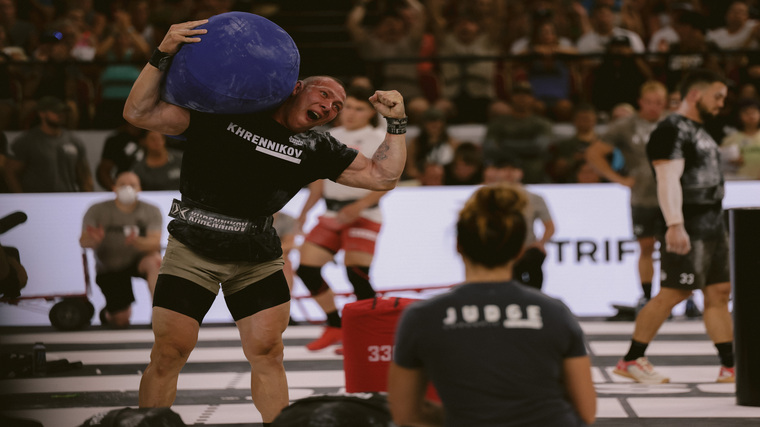
What new movements and standards were introduced in the 2022 CrossFit Games, and how did athletes face these challenges? Read on to find out.
New Movements at the 2022 CrossFit Games
- Single-Unders
- Strict Pegboard Ascents
- Double-Under Crossover
- Dips with Parallel Bar Traverses
- Wall-Facing Deficit Handstand Push-Up
- Sandbag-to-Shoulder
- The Alpaca Sled
- Kettlebell Clean & Jerks
- Legless Rope Climbs (Legless Ascent and Descent)
Event Three — Skill Speed Medley
The first evening of the Games came fully equipped with five new movement standards for the Games. Skill Speed Medley was exactly what it sounded like — a medley of a wide array of different technique-intensive skills, performed at high speed to beat the time cap.
Single-Unders
Single-unders were in the first round of the event. Athletes had to complete 75 unbroken reps before advancing to the next movement. It became obvious very quickly that several competitors may not have practiced single unders in a very long time. We saw athletes trip and change technique to running in place as they skipped rope, compensating for the slowed timing of the single-under. In a rare competition mishap, Tia-Clair Toomey stumbled on her rope.
Strict Pegboard Ascents
Bozman also introduced strict pegboard ascents (the pegboard was also in the 2021 Games), which required athletes to climb the board legless, relying completely on their upper body strength. A new pistol squat standard also greeted athletes, requiring them to perform all of the prescribed reps on one leg before switching to the other side. The non-working foot was not allowed to touch the ground, putting a huge demand on the balance of the athletes.
Double-Under Crossover
And then there was the double-under crossover. This one stopped nearly the entire field in their tracks, with only three competitors — soon-to-be-crowned 2022 Rookie of the Year Nick Mathew, Guilherme Malheiros, and now two-time Fittest Man on Earth® Justin Medeiros — getting through the 25 prescribed reps before the time cap.
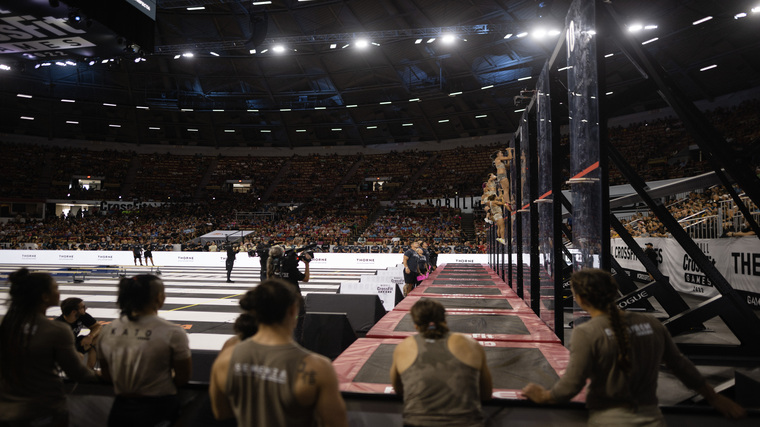
[Read More: The Best Upper Body Exercises and Workouts]
The last movement introduced was the L-sit to handstand walk (handstand course). Athletes who made it through to the final round faced this move down. They had to perform an L-sit on parallel bars then transition their feet under and up into a handstand. This was paired with an unbroken handstand walk across the parallel bars and down a ramp to the finish line. Mathew and Malheiros were able to figure this out, but even Medeiros struggled and couldn’t quite get it down.
Event Three Workout
Three rounds of races through pegboards, jump ropes, pistol squats, and handstand walks:
Quarterfinal Round:
- Pegboard Ascents — Men: three ascents | Women: two ascents
- 75 Unbroken Single-Unders
- 10 Unbroken Pistol Squats (Left)
- 10 Unbroken Pistol Squats (Right)
- Handstand Walk Course
Semifinal Round:
- Strict Pegboard Ascents — Men: two ascents | Women: one ascent
- 50 Unbroken Double-Unders
- 10 Unbroken Pistol Squats (Left)
- 10 Unbroken Pistol Squats (Right)
- Handstand Walk Course (Pirouette Start)
Final Round:
- One Strict Pegboard Ascents
- 25 Double-Under Crossovers
- 10 Unbroken Pistol Squats (Left)
- 10 Unbroken Pistol Squats (Right)
- Handstand Walk Course (Low Start)
Time cap: three minutes.
[READ: BarBend’s Event Three Recap and Results]
Event Four — Elizabeth Elevated
The parallel bar dip with a traverse was introduced for Event Four, spicing up the classic CrossFit benchmark workout “Elizabeth.”
Dips with Parallel Bar Traverses
This new standard forced the athletes to break each round into three sets of dips, with a traverse across the parallel bars before performing each set.
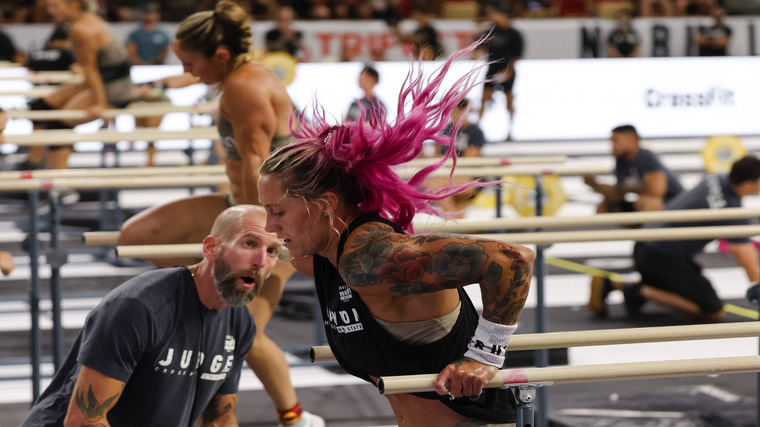
The standard was that once the athlete hopped up and began their traverse across the bars, they had to complete the prescribed number of dips unbroken before coming down to rest. This required athletes to really know their body — and the spring of the parallel bars — to prevent jumping up too early at the risk of failing a set of dips.
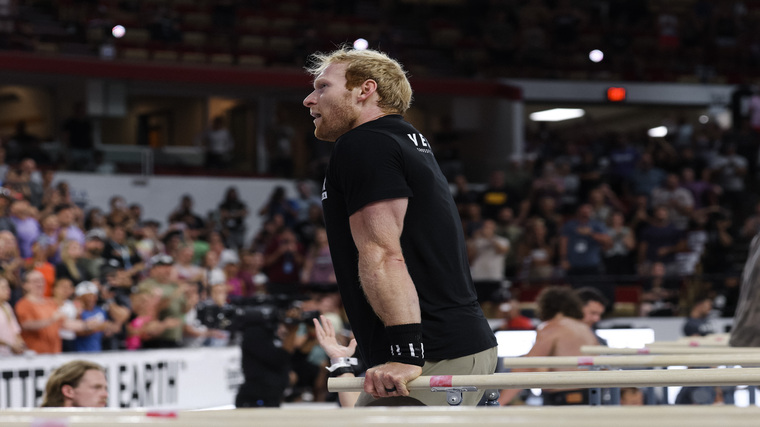
We saw Tia-Clair Toomey struggle with this more than she traditionally would on other gymnastics movements. Pat Vellner dominated the men’s field, taking in the moment — and maximizing his gymnastics background — while enjoying his victory with a memorable celebration.
Event Four Workout
21-15-9-9-9 reps for time of:
- Squat Cleans
- Dips with Parallel Bar Traverses
Time cap: Women — 12 minutes, Men — 10 minutes
Women: 95-pound cleans | Men: 135-pound cleans
[READ: BarBend’s Event Four Recap and Results]
Event Seven — Echo Press
Deficit handstand push-up variations have been a staple at the elite level of CrossFit for years. The wall walk was introduced for the first time back in the 2021 Open, where it was later tested at the Games coupled with heavy barbell thrusters. This year, we saw a new twist that combined the wall walk and handstand push-up into one movement.
Wall-Facing Deficit Handstand Push-Up
The wall-facing deficit handstand push-up forced athletes to wall walk up blocks to the starting position, before starting their deficit handstand push-up reps. While some athletes — including Alexis Raptis, who took home the event win on the women’s side — blazed through this new movement with ease, others struggled. Many athletes faced no-rep after no-rep, and podium-finisher Ricky Garard saw his worst performance of the weekend.
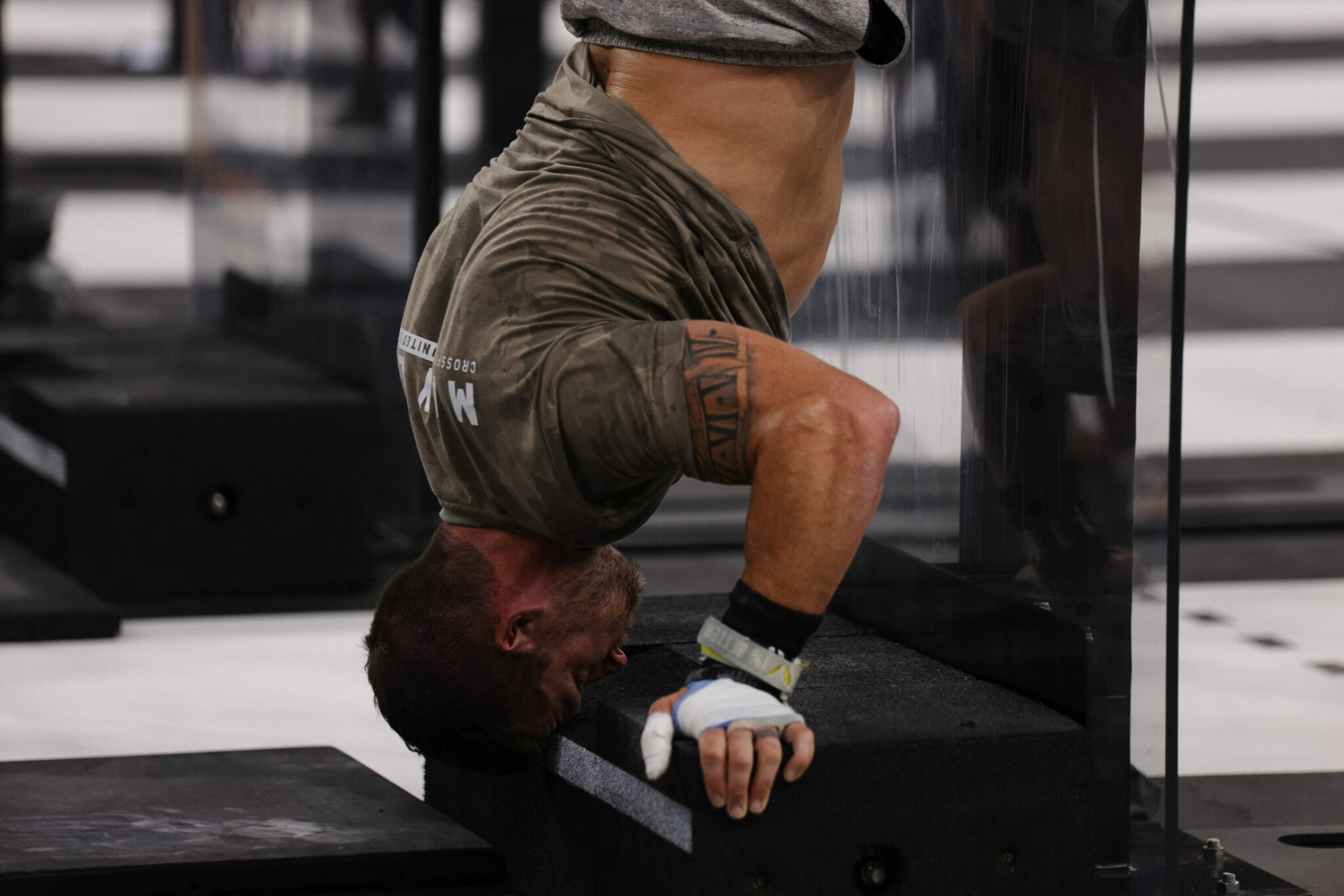
Since so many of the elite games athletes struggled with this movement, it could be something the Games see repeated in years to come (as we saw with the pegboard back in 2015). The real question is if we will see a variation of this in the CrossFit Open. Could we see a wall walk and wall-facing handstand push-up combination within the next couple of years?
Event Seven Workout
For time:
- Echo Bike — Men: 30 calories | Women: 25 calories
- 10 block Handstand Push-Up
- Echo Bike — Men: 20 calories | Women: 15 calories
- 10 block Handstand Push-Up
- Echo Bike — Men: 20 calories | Women: 15 calories
- 10 block Handstand Push-Up
- Echo Bike — Men: 30 calories | Women: 25 calories
Women: two-inch deficit | Men: 3.5-inch deficit
Time cap: Men, 10 minutes, Women, 12 minutes
[READ: BarBend’s Event Seven Recap and Results]
Event 10 — Sandbag Ladder
For the first time in CrossFit Games history, the one-rep max strength event did not include a barbell. This was a monumental surprise, as strength has historically been tested with a variation of the Olympic lifts (snatch and clean & jerk), and/or The CrossFit Total (back squat, overhead press, and the deadlift).
Sandbag-to-Shoulder
Since most games athletes don’t train the sandbag-to-shoulder for absolute strength, this move forced competitors to figure out the most efficient technique as the event progressed. Pro strongman Jerry Pritchett was even on hand to help the athletes out with technique advice — for example, gathering the bag into their laps and rolling it up to their shoulders rather than loading it directly.
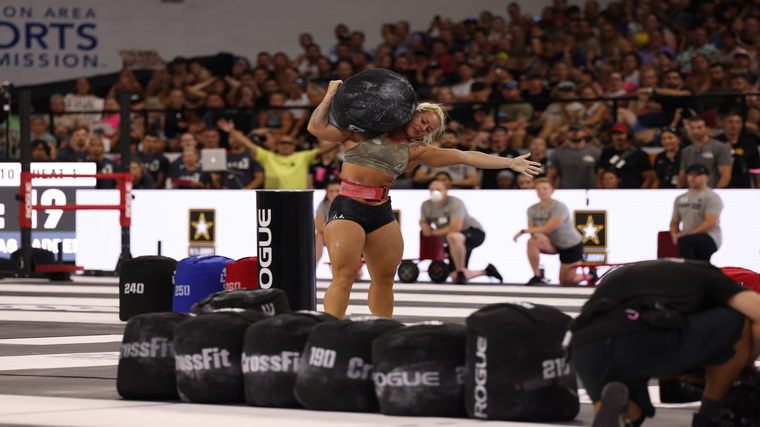
The atmosphere on the floor was electric and there was a sense of camaraderie between competitors that displayed how much fun they were having with this event. Dani Speegle and Jaqueline Dahlstrøm stole the show on the women’s side. Speegle hefted a 250-pound sandbag with what looked like relative ease to take the event win, while Dahlstrøm hiked a 240-pound bag — 1.6 times her body weight — up inch by inch to secure second place.
On the men’s side, the 340-pound bag that initially was to serve as the heaviest weight proved not enough for Malheiros, Mathew, Brent Fikowski, and Jayson Hopper. Organizers had to wheel out a 350-pound bag for the men to attempt. While none could secure the — ahem — bag, Fikowski did get it onto his shoulder and manage to toss out his arm; however, it was ruled not stable enough to be a good lift. With a little more practice and familiarity with the move, who knows what weights athletes will be able to achieve should this event return to the Games.
Event 10 Workout
- One-rep-max Sandbag-to-Shoulder
Women: Bags from 160-250 pounds | Men: Bags from 240-340 pounds
[READ: BarBend’s Event 10 Recap and Results]
Event 11 — The Alpaca
The grunt work theme continued into Sunday, with the introduction of a new version of the sled being introduced.
The Alpaca Sled
This apparatus — the Alpaca Sled, designed by Rogue Fitness specifically for this event — was built to be loaded with objects, with the base having a basket design similar to a wheelbarrow. This event had athletes unloading and then reloading heavy kettlebells to the sled.

[Read More: Our Favorite Forearm Workouts, + the Best Forearm Exercises]
The versatility of this design could be something we see used for many years to come, as it will allow for creativity of the different objects used in the future.
Kettlebell Clean & Jerks
Heavy kettlebell clean & jerks also showed up in these Games. While the Games have seen kettlebell deadlifts, kettlebell thrusters, kettlebell swings, this variation was a first. Kettlebell shoulder-to-overheads were featured at the Games in 2019, but that workout was for high reps — whereas The Alpaca was specifically designated as a jerk, and it was for strength.
These barbell-experienced athletes this time had to contend with a high-skill — and heavy — kettlebell clean & jerk in Madison. Multiple competitors failed reps on the jerk portion of the movement, and even those who blazed through the event — like Roman Khrennikov, Speegle, and Laura Horvath — seemed to get through based on strength rather than practiced technique.
Legless Rope Climbs (Legless Ascent and Descent)
The weather caused the legless rope climbs to be removed, which changed the stimulus of the workout, shifting it to favor the bigger, stronger athletes. The original programming introduced a new legless rope climb standard, where the reps would begin from a seated position and finish with a mandatory legless descent from the top of the rope. This puts a huge magnifying glass on upper body pulling and grip strength. Since the rain didn’t let the 2022 Games debut this standard, you might expect to see it in years to come.
Event 11 Workout
For time:
- 126-foot Sled Push (decreasing in load)
- 20 Kettlebell Clean & Jerks
- 42-foot Sled Push with Two Kettlebells
- 15 Kettlebell Clean & Jerks
- 42-foot Sled Push with Four Kettlebells
- 10 Kettlebell Clean & Jerks
- 42-foot Sled Push with Six Kettlebells
Women: Six 24-kilogram kettlebells | Men: Six 32-kilogram kettlebells.
Time cap: 18 minutes.
[READ: BarBend’s Event 11 Recap and Results]
The Future of the CrossFit Games
In Adrian Bozman’s first year as CrossFit’s Director of Competition, he introduced multiple new movement variations and standards. The Games shifted away from the barbell toward strongman implements and gymnastics classics to test strength, stamina, and adaptability.
The 2022 Games were yet another test of the competitors’ overall athleticism and adaptability. But that didn’t produce a change at the top of the leaderboard. Tia-Clair Toomey is now the Fittest Woman on Earth® for the sixth time, making her the winningest individual athlete in the sport’s history. Justin Medeiros earned the title of Fittest Man on Earth® for the second year running. But with everything from strongman to even more gymnastics in play, fans are still wondering what will come next — both in the 2023 Open and in next year’s Games.
Featured Image: William Johnson (@barbellstories on Instagram)